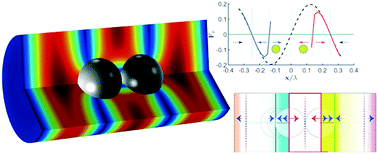Trapping and patterning of large particles and cells in a 1D ultrasonic standing wave†
Abstract
The use of ultrasound for trapping and patterning particles or cells in microfluidic systems is usually confined to particles which are considerably smaller than the acoustic wavelength. In this regime, the primary forces result in particle clustering at certain locations in the sound field, whilst secondary forces, those arising due to particle–particle interaction forces, assist this clustering process. Using a wavelength closer to the size of the particles allows one particle to be held at each primary force minimum. However, to achieve this, the influence of secondary forces needs to be carefully studied, as inter-particle attraction is highly undesirable. Here, we study the effect of particle size and material properties on both the primary and secondary acoustic forces as the particle diameter is increased towards the wavelength of the 1-dimensional axisymmetric ultrasonic field. We show that the resonance frequencies of the solid sphere have an important role in the resulting secondary forces which leads to a narrow band of frequencies that allow the patterning of large particles in a 1-D array. Knowledge regarding the naturally existent secondary forces would allow for system designs enabling single cell studies to be conducted in a biologically safe manner.



 Please wait while we load your content...
Please wait while we load your content...